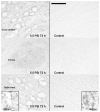A mouse model of blast-induced mild traumatic brain injury
- PMID: 21946269
- PMCID: PMC3202080
- DOI: 10.1016/j.expneurol.2011.09.018
A mouse model of blast-induced mild traumatic brain injury
Abstract
Improvised explosive devices (IEDs) are one of the main causes for casualties among civilians and military personnel in the present war against terror. Mild traumatic brain injury from IEDs induces various degrees of cognitive, emotional and behavioral disturbances but knowledge of the exact brain pathophysiology following exposure to blast is poorly understood. The study was aimed at establishing a murine model for a mild BI-TBI that isolates low-level blast pressure effects to the brain without systemic injuries. An open-field explosives detonation was used to replicate, as closely as possible, low-level blast trauma in the battlefield or at a terror-attack site. No alterations in basic neurological assessment or brain gross pathology were found acutely in the blast-exposed mice. At 7 days post blast, cognitive and behavioral tests revealed significantly decreased performance at both 4 and 7 m distance from the blast (5.5 and 2.5 PSI, respectively). At 30 days post-blast, clear differences were found in animals at both distances in the object recognition test, and in the 7 m group in the Y maze test. Using MRI, T1 weighted images showed an increased BBB permeability 1 month post-blast. DTI analysis showed an increase in fractional anisotropy (FA) and a decrease in radial diffusivity. These changes correlated with sites of up-regulation of manganese superoxide dismutase 2 in neurons and CXC-motif chemokine receptor 3 around blood vessels in fiber tracts. These results may represent brain axonal and myelin abnormalities. Cellular and biochemical studies are underway in order to further correlate the blast-induced cognitive and behavioral changes and to identify possible underlying mechanisms that may help develop treatment- and neuroprotective modalities.
Published by Elsevier Inc.
Figures










References
-
- Aggleton JP, Keen S, Warburton EC, Bussey TJ. Extensive cytotoxic lesions involving both the rhinal cortices and area TE impair recognition but spare spatial alternation in the rat. Brain Research Bulletin. 1997;43:279–287. - PubMed
-
- Andreasen NC. Acute and delayed posttraumatic stress disorders: a history and some issues. The American Journal of Psychiatry. 2004;161:1321–1323. - PubMed
-
- Arciniegas D, et al. Attention and memory dysfunction after traumatic brain injury: cholinergic mechanisms, sensory gating, and a hypothesis for further investigation. Brain Inj. 1999;13:1–13. - PubMed
-
- Barnum CJ, Tansey MG. (in press) The duality of TNF signaling outcomes in the brain: Potential mechanisms? Experimental Neurology. 2011 (in press) - PubMed
-
- Basser PJ, Pierpaoli C. Microstructural and physiological features of tissues elucidated by quantitative-diffusion-tensor MRI. Journal of Magnetic Resonance. 1996;111:209–219. - PubMed
Publication types
MeSH terms
Grants and funding
LinkOut - more resources
Full Text Sources
Other Literature Sources
Research Materials

